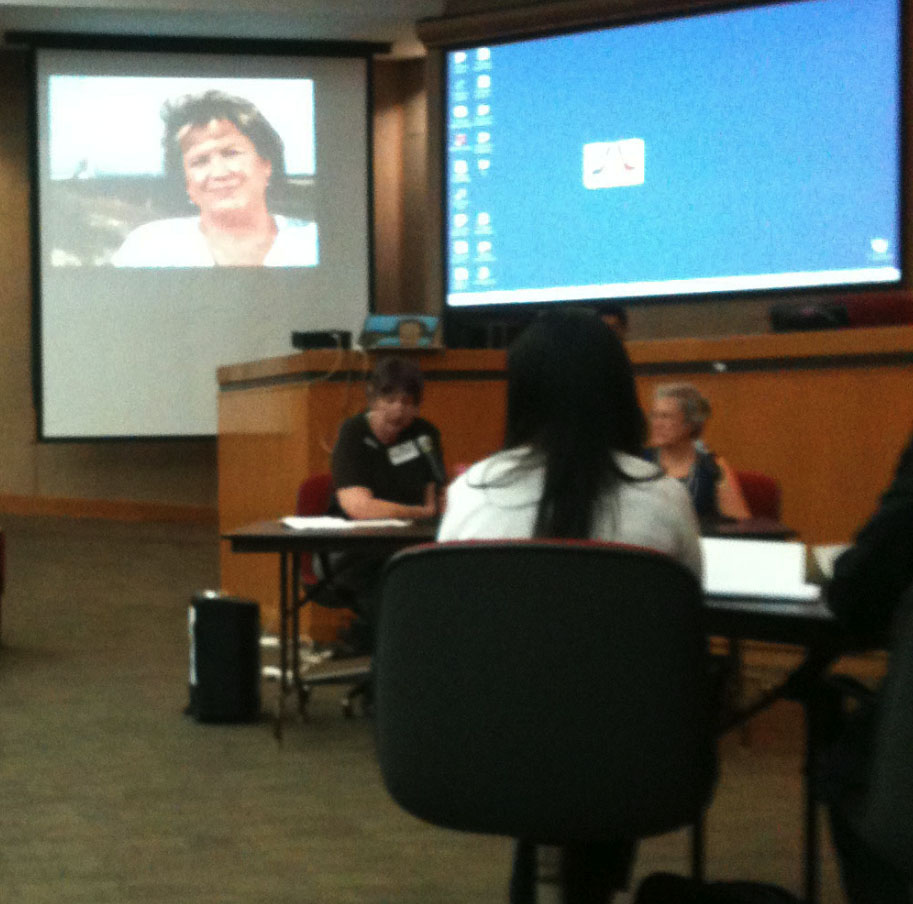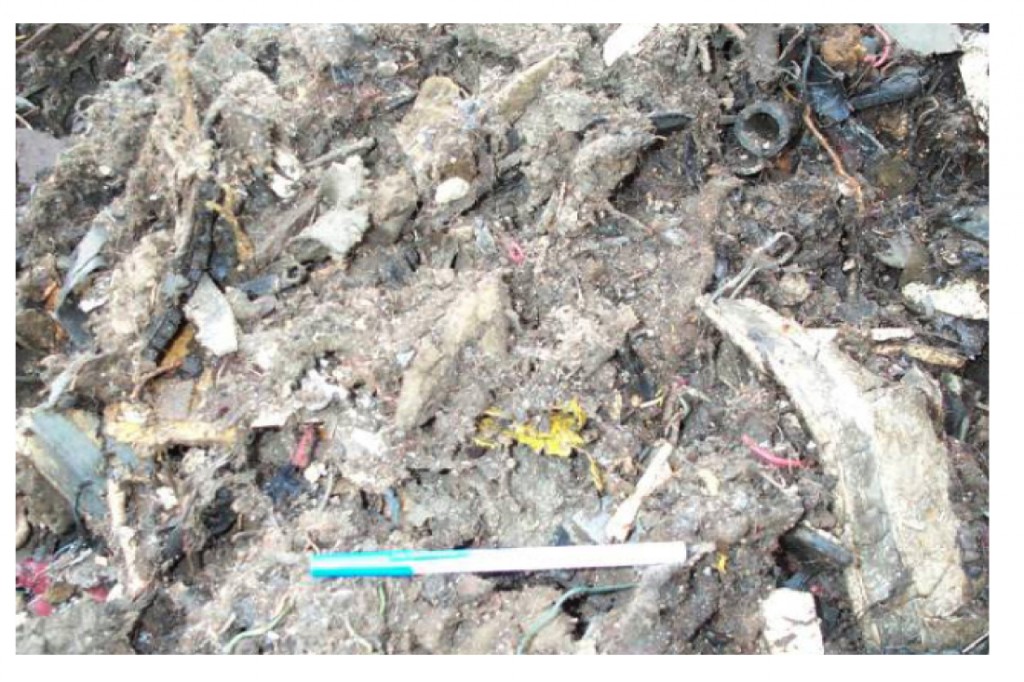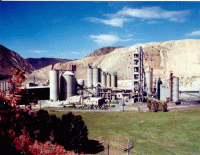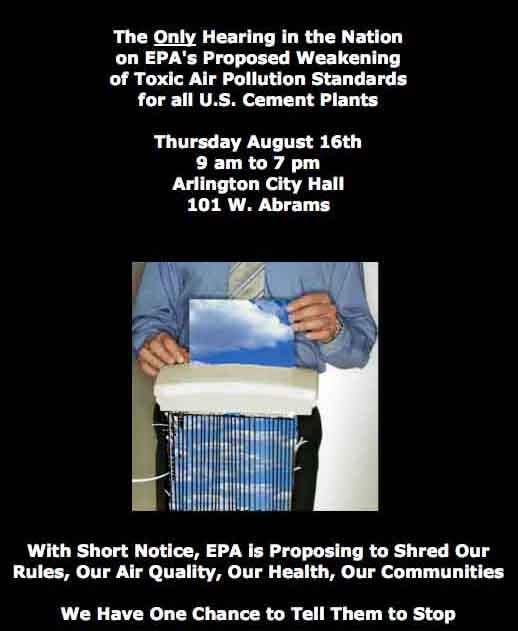Cement
The Miracle of Our Perpetually-Projected Lady of the Public Hearing
 In 2009, when there was an EPA national hearing in DFW on the then-proposed cement plant air pollution rules, the mood was festive. There was a brand new administration. There was a campaign for a brand new EPA regional chief from our own ranks gearing up. The brand new air pollution rules at the center of the hearing were capping a two-decade old fight to enforce the law. They were symbolic of a shift in momentum. Citizens had won. The event was held in a large hotel ballroom, and indeed, for citizens who had been a part of that fight, it felt like a day-long celebration.
In 2009, when there was an EPA national hearing in DFW on the then-proposed cement plant air pollution rules, the mood was festive. There was a brand new administration. There was a campaign for a brand new EPA regional chief from our own ranks gearing up. The brand new air pollution rules at the center of the hearing were capping a two-decade old fight to enforce the law. They were symbolic of a shift in momentum. Citizens had won. The event was held in a large hotel ballroom, and indeed, for citizens who had been a part of that fight, it felt like a day-long celebration.
Three years later, the party was over. The newness had worn off. A once "indefensible" Bush-era ozone standard that was going to be replaced, was instead adopted by the new administration. Dr. Al had won appointment, only to pummeled into resignation by a political mugging that left even the most cynical shaking their heads. Grim persistence was the most common trait shared among the citizens who faithfully trooped to Arlington City Hall for last Thursday's national EPA hearing, where those same rules were now under attack by the Agency itself. It may have only been three calendar years, but that ballroom scene seemed sepia-toned distant now.
Which makes the attendance at Thursday's hearing more remarkable in some ways than the large crowd that gathered in 2009. Then, clean air advocates occupied 88 out of around 93 or so speaker slots available for the all-day hearing. Last week, they occupied 83 out of 86 slots. The faithful were coming, but they weren't happy about it. Isn't that always the case in these stories? Right before the faithful are rewarded with a sign?
The first speaker of the day was young Andy O'Hare of the Portland Cement Association, who, despite being on what appears to be the winning side of this battle, didn't look like he was having a good time. He dutifully and stiffly read a prepared statement that took a pro-delay stance and applauded EPA for being reasonable, i.e. agreeing with the PCA. Justification for the delay was evidenced with the help of a laminated multi-colored poster of a seven-step explanation/timeline that he held up himself without aid of easel or stand. "This timeline," he said as his unsteady grasp floated the graphic on a sea of nervous energy, "reflected the fact that the industry had concluded without a doubt that it would need exactly two years to adapt to the rules. You just had to add up the steps." It looked enough like a high school science fair project at this point for you to wonder why this industry can't invest in better PR help. We're losing to these guys?
Except from some of the same kind of praise by the Texas Cement Council, and the obligatory "We don't even agree tighter standards are necessary" rhetoric from the Texas Association of Business representative, that was the extent of testimony in favor of EPA's last-minute rollback. No individual cement manufacturers spoke. Not even TXI, headquartered only about 20 miles away in Dallas. They must think they have it in the bag.
Following O'Hare, Downwinders Director Jim Schermbeck testified in the place of Downwinders' matriarch and founder Sue Pope. News came on Friday that doctors told the 72-year old Midlothian rancher that she needed a heart transplant. Everyone thought it was a good idea for her to sit the hearing out.
But Schermbeck didn't let that happen. Not exactly. Even before any testimony began, he projected a picture of Pope on a screen above the proceedings. She was staring down at Andy when he testified. Maybe that's what made him nervous.
"These are not industry's rules. These are not EPA's rules. They are Sue Pope's rules, and you shouldn't be messing with them," said Schermbeck. Tracing Pope's 25-year fight to reduce pollution in her hometown, he told the EPA panel she and a handful of others were actually responsible for the rules and it was now destroying them. "EPA has shat on everything Sue Pope has worked for with these proposed revisions, and it should be deeply, deeply, ashamed." He concluded his five minutes by feeding a letter-size version of the same picture of Pope that was being projected larger than life into the desk-size shredder that had been donated for the purpose of telling EPA what they were destroying with their rollback. Schermbeck said the proposed delay and revision was now destroying the woman herself.
Schermbeck wanted to leave that larger-than-life image of Sue up on the screen for as long as anyone in charge would allow. He wanted it to hang like a spectre over the entire day's proceedings. But he knew the screen saver feature on his computer powering the projection would eventually kick-in and make everything go dark. It always does. He's been doing presentations with this combination of equipment for years now and it always goes dark after 10-15 minutes. He'd forgotten to turn it off for this hearing, and now it was going to kick in any minute.
Only it didn't. He kept waiting and waiting. The screen saver never came on. A five-foot Sue Pope head remained there, hovering over the Council Chamber, with eyes as large as dinner plates looking down and directly at the EPA officials taking testimony (Howdy Keith Barnett!), all day long, all 10 hours. Sue Pope was the Alpha and Omega of the hearing.
It wasn't a piece of toast or a tree trunk. But through some unexplainable mix-up of electrons, a real true life saint did make an appearance at the EPA hearing. The official minutes won't reflect it, but for the faithful, the sign was clear: Never, never, never, never, never, never, never ever give up.
Under Ms.Pope's gaze, there was a long parade of poignant and moving testimonials, most finding different ways to say "hell no" five minutes at a time.
Clint Forsvall talked about the thousands of tons of Mercury the EPA's proposed delay would dump into the air, and why, as a parent of an autistic child, that was abhorrent to him. Midlothian resident Alexandra Allred spoke about how often she's had to take her son to the emergency room for middle-of-the-night asthma attacks.
The Galemore family from Chanute, Kansas came and educated everyone on what it's like to live in an isolated cement company town where hazardous waste is still being burned and where there's no independent media, or effective government oversight. Susan Falzone from Hudson, New York came and talked about the 100-year old history of cement plant pollution in that precious river valley. Kemp Burdette from Riverkeepers in North Carolina took on the proposed giant Titan plant. Stephanie Maddin from EarthJustice in DC spoke on behalf of those that couldn't make it to Arlington due to the ridiculous 11-day notice.
Local COPD victim Harriet Irby testified why every little big of air pollution reduction helps her in the daily chore of breathing. Arlington regular thorn-in-the-side-of industry Kim Feil was there with Ben Zene. Retired physician Dr. Robert Portman gave a primer on Particulate Matter pollution. Someone showed up at the last minute after hearing about it only that day to plead for less poisons in the air. It was, she said, important to her.
Most impressive was how so many people that had come to praise EPA in 2009 now came trudging back to try and do their part to keep the rules intact. These are people who know the power of persistence, even when it's in the cause of a rearguard action that shouldn't even be taking place.
Given EPA's transparent intent to steamroll the revisions into law, did we do any good at all? We don't know. But we did our job. EPA tried to make it impossible to get people to come and show their outrage. People, lots of people, came anyway. EPA may still go through with these senseless revisions, but they'll have to do it without a scintilla of public support. We robbed them of that fig leaf.
And we don't know about you, but we're taking the miracle of Our Perpetually-Projected Lady of the Public Hearing as a sign that, although it's highly unlikely that a woman with no technical training, no money, and no political support can, with the help of other similarly-deranged citizens, eventually bring an entire national industry kicking and screaming into the 21st Century…..it can happen.
Thanks Much.
Thanks to everyone who showed-up on Thursday. More on Monday, but this will give you a run down on who spoke.
Citizens Plan to “Shred” EPA at Cement Plant Rules Hearing
 WHAT: The Nation's Only Public Hearing on the EPA's Rollback of Cement Plant Air Pollution Standards
WHAT: The Nation's Only Public Hearing on the EPA's Rollback of Cement Plant Air Pollution Standards
WHEN: 9am to 7 pm Thursday, August 16th
WHERE: Arlington City Hall, 101 W. Abram
(Arlington)—Opponents of an EPA proposal to rollback new cement plant air pollution standards will incorporate a paper shredder into their comments at an all day national EPA hearing at Arlington on Thursday.
"Sometimes words aren't enough to express your outrage. You need an action that speaks louder. Our shredder is pretty loud," said Downwinders at Risk Director Jim Schermbeck, whose group is leading an effort to recruit 100 speakers to fill every 5-minute speaking slot from 9 an to 7pm.
He and others plan to use the shredder to show the EPA what's at stake in the agency's last-minute reversal of key parts of the first ever national toxic air pollution emission standards.
They're bringing pictures of relatives with pollution-related illnesses, copies of the Clean Air Act, health care bills, and the EPA's iconic logo to feed into the shredder to help drive home the personal and public effects of the agency's proposed two-year delay and increase in soot pollution.
"With this regulatory mugging, EPA is shredding air quality, it's shredding public health, its shredding public confidence. We're just showing the results," said Schermbeck.
Despite only 11 days notice for a national hearing in the middle of August, he predicts citizens will come close to meeting their goal of filling all available speaking slots. It's the only hearing EPA is holding as it considers the changes to the original federal 2010 cement plant pollution standards that were hailed by the same groups now protesting a retreat.
Groups are expected to be joined in their rejection of the rollback by North Texas area elected officials or members of their staff, including Congresswoman Eddie Bernice Johnson, State House Representative Lon Burnam, Dallas County Judge Clay Jenkins, prospective Congressional Representative Mark Veasey, and State Senator Wendy Davis.
In 2009, approximately 90 people testified at a similar DFW hearing as the rules were up for final adoption. Dallas-Ft. Worth is downwind of the nation's largest concentration of cement plant manufacturing, with three large plants located within only a few miles of each other in Midlothian. The plants have been the center of environmental and health controversies since the late 1980's and made North Texas a hotspot of citizen opposition to industry pollution.
Having finally been adopted after 20 years of lawsuits, the new emission standards were on their way to be singed into law by President Obama this summer when EPA suddenly pulled them and announced they wanted to delay implementation from next year to 2015 while also loosening emission standards for Particulate Matter pollution. In evaluating the results of the revision, EPA admitted it will increase PM pollution from the nations cement plants by 135 tons a year.
Previous EPA studies had calculated how many lives would be saved by the standards. Citizens have seized on these estimates to now calculate the harm of the agency's two-year delay, putting the national death toll at between 2-5,000 lives using the EPA's own numbers.
Because of the amount of pollution generated in Midlothian and the population density of DFW, a significant portion of those deaths will be local residents.
No court ordered the after-the-fact revisions. In fact, the rules had survived their very last court challenge last December. Schembeck says that makes the rollback even more mysterious.
"EPA is going out of its way to deny citizens what they were on the verge of winning – the first ever federal air pollution standards for the nation's cement plants," Said Schermbeck. "They're robbing people who've been working on this issue for over 20 years for no good reason. We're not going to be quiet as they try to take away what we've rightfully earned."
Please Take 5 Minutes to Defend What it Took Us 20 Years to Build
Nation’s Only Public Hearing on Roll Back of Cement Plant Rules Scheduled for Aug 16th in DFW
 Environmentalists are angry at EPA for giving the public less than two weeks notice prior to the nation's only hearing on a rollback of new air pollution rules for cement plants that the agency says could save thousands of lives annually, including many in DFW.
Environmentalists are angry at EPA for giving the public less than two weeks notice prior to the nation's only hearing on a rollback of new air pollution rules for cement plants that the agency says could save thousands of lives annually, including many in DFW.
One of those who came in 2009, and vowed to show up again on the 16th was Ft. Worth resident Margaret DeMoss, who was instrumental in getting her city to adopt a "green cement" policy to reduce pollution from obsolete Midlothian cement kilns in southern DFW.
She also noted that in 2009, when the rules were being proposed, there were three national hearings coast to coast. Now that the rules are being weakened, there's only one.
"It's outrageous that the EPA would schedule this hearing at the last minute and in only one location in the nation; lot of other regions suffer downwind from cement kilns. Who will speak for them?"
Downwinders at Risk and other community groups repeatedly sued to get them enforced. That effort resulted in 2010 emission rules that were hailed as the largest single advance in air quality for the US cement industry, and were universally supported by citizens living near and around the nation's cement plants.
They had already passed all necessary regulatory review, just overcome their last legal hurdle, and were on their way to President Obama for his signature and implementation by 2013 when they got yanked by the administration's Office of Management and Budget earlier this year.
When the rules re-emerged, their enforcement was pushed back to 2015 and their strict Particulate Matter pollution provisions were considerably weakened.
According to EPA's own health impact studies for the rules, that two-year delay will cause at least 2000-5000 premature deaths nationwide.
Despite a halt in the burning of hazardous wastes at local cement plants in 2010, MIdlothian remains the home of the largest concentration of cement manufacturing in the entire U.S.
Three large cement plants – TXI, Holcim, and Ash Grove – are still the largest point sources of air pollution in North Texas, generating thousands of tons of air pollution.
Since DFW is downwind of Midlothian, Metroplex residents are exposed to more cement plant pollution than any other metropolitan area in the country, and represent a disproportional number of these 2-5000 annual deaths that EPA estimates will occur because of its rules delay.
"If these revisions are adopted, DFW residents will be paying a high price for the Administration's retreat," said Schermbeck. "That's why we must make our objections heard now."
He urged those that want to speak at the August 16th hearing to reserve a five-minute slot with EPA coordinator Pam Garrett by e-mailing her at garrett.pamela@epa.gov or calling (919) 541-7966
Groups Demand DFW Hearing on EPA’s Rollback of Cement Plant Rules
 In a letter sent Tuesday, ten grassroots and national groups from across the country, including Downwinders at Risk, joined together to call on EPA to schedule a public hearing in Dallas-Ft. Worth on its proposed rollback of cement plant emission rules.
In a letter sent Tuesday, ten grassroots and national groups from across the country, including Downwinders at Risk, joined together to call on EPA to schedule a public hearing in Dallas-Ft. Worth on its proposed rollback of cement plant emission rules.
In publishing the revised rules in the Federal Register last week, EPA proposed only one public hearing be held on August 2nd in North Carolina, where there is not a single operating cement plant, although the proposed new giant Titan cement plant is trying to win permit approval to operate near Cape Fear.
Downwinders was joined by Montanans Against Toxic Burning out of Bozeman; Montana Environmental Information Center in Helena; Selkirk, Coeymans, Ravena Against Pollution (SCRAP) in upstate New York; California Communities Against Toxics, based in Rosamond, the Stop Titan Action Network, Penderwatch and Conservancy, Cafe Fear River Watch, and North Carolina Coastal Federation, all from the Tarheel state, as well as Earthjustice, the DC-based legal defense team that has partnered with Downwinders and many of the other groups for 20 years in trying to get these new rules implemented.
In 2009, DFW was one of three metropolitan areas that hosted public hearings on the then-proposed rules, referred to as National Emission Standards for Hazardous Air Pollutants, or NESHAP. Over 200 people attended at the impossible-to-get-to DFW Airport Hotel and almost 100 testified – more than participated in the DC and LA hearings combined. All but five testified in favor of strong EPA regulation of cement plant emissions.
DFW is also downwind of the nation's largest concentration of cement plant manufacturing capacity, with three large plants and a total of six kilns operating today in Midlothian, in Ellis County.
EPA's changes to the rules, which include moving the compliance deadline from 2013 to 2015, as well as loosening the Particulate Matter standards and eliminating real time monitoring of PM pollution, were proposed just as the rules were about to be finalized and signed into law. No one at EPA can explain exactly why. No judge asked them to. The public didn't demand it. The Administration seems to be going out of its way to find favor with the cement industry even as the EPA is still carrying on a massive national enforcement initiative against it.
If you haven't done so already, please click here and send your comments opposing the changes in the cement plant emission rules. You only have until August 17th.
The full text of the groups' letter:
We, the undersigned groups, respectfully request that the Environmental Protection Agency hold a public hearing in Dallas, TX on its recently re-proposed NESHAP rule for Portland cement kilns. We request that this hearing be held in addition to the hearing scheduled at the Research Triangle Park facility in North Carolina.
There are no cement plants operating in North Carolina. It is incredibly important for the EPA to hold at least one public hearing in a location that is directly impacted by the toxic air pollution that this NESHAP rule addresses. Dallas is an appropriate additional hearing location for numerous reasons. First, there are multiple cement plants in the vicinity. Second, there is a precedent for public hearings on this rule in the region— on June 17, 2009, the EPA held a productive public hearing in Dallas on the Portland cement NESHAP. Third, Dallas's central location is more convenient for other impacted citizens from across the country who wish to travel to provide testimony.
We have worked for more than a decade to secure strong protections against the emissions of mercury, arsenic and other toxic air pollutants that cement plants emit. We would appreciate the opportunity to continue our involvement on this important issue at an additional public hearing in Dallas.
German Cement Plants Now Mostly Waste Burners
 The cement industry calls it "alternative fuel" or "co-generation," but it's really just waste burning. This was true during the 1980's and 90's when the cement industry began converting kilns to large hazardous waste incinerators, and it's true now that the industry is trying to turn kilns into giant garbage incinerators. In one permit request after another across the country, cement plants are adding not just used tires and oil, but plastics wastes, automobile interiors and anything else they can get in bulk to the list of "fuels" they can burn. Locally, TXI's 2011 "permit amendment" allows the Midlothian kiln to burn a long lists of industrial wastes. To see where this leads, look no further than Germany, where fully 61% of all fuel consumed in that nation's cement kilns in 2011 was provided by plastics, used tires, and used oils. It's worth noting that European emissions requirements are usually stricter than EPA's, but the figure is still alarming since it was only about 30% in 2000.
The cement industry calls it "alternative fuel" or "co-generation," but it's really just waste burning. This was true during the 1980's and 90's when the cement industry began converting kilns to large hazardous waste incinerators, and it's true now that the industry is trying to turn kilns into giant garbage incinerators. In one permit request after another across the country, cement plants are adding not just used tires and oil, but plastics wastes, automobile interiors and anything else they can get in bulk to the list of "fuels" they can burn. Locally, TXI's 2011 "permit amendment" allows the Midlothian kiln to burn a long lists of industrial wastes. To see where this leads, look no further than Germany, where fully 61% of all fuel consumed in that nation's cement kilns in 2011 was provided by plastics, used tires, and used oils. It's worth noting that European emissions requirements are usually stricter than EPA's, but the figure is still alarming since it was only about 30% in 2000.
“How your great grandmother’s chemical exposures may affect you”
 In a study published this week, "rats exposed in the womb to five common environmental pollutants passed on DNA-changing attributes that persisted in causing ovarian cancer three generation removed from the original exposure."
In a study published this week, "rats exposed in the womb to five common environmental pollutants passed on DNA-changing attributes that persisted in causing ovarian cancer three generation removed from the original exposure."
It's another example of "epigenetics" – when harmful environmental exposures to one generation can skip a generation or two and show up as health effects decades later.
According to the new study, the five pollutants reprogram how DNA is expressed in the developing fetus' eggs, setting the stage for ovarian disease later in their life.
If you're a Vet, the news is worse. The U.S. Department of Defense helped select the pollutants based on potential exposures in military personnel. They included vinclozolin, a fungicide that's used in the wine industry; a pesticide mixture including permethrin and DEET; a plastic mixture including bisphenol A (BPA) and two widely used phthalates (DEHP and DBP); the industrial byproduct dioxin; and a hydrocarbon mixture called "jet fuel," which is used to control dust on road surfaces.
Researchers at Washington State University exposed pregnant rats to one of five different chemicals alone or in mixtures during a critical time of pregnancy when their daughter pups' eggs were developing. The pups were then mated with males from the same treatment group, and the resulting pups were bred yet again. Only the original generation of pregnant rats had been exposed to the chemicals. The adult daughters and great granddaughters of the dosed animals (called the F1 and F3 generations) were examined for ovarian disease.
In all exposure groups, both the daughter (F1) and great-granddaughter (F3) mice had fewer egg follicles in their ovaries compared to controls, indicating a reduced pool of available eggs. Both generations – but particularly the F3 animals – also had an increased number of ovarian cysts compared to controls.These findings are characteristic of Polycystic Ovarian Syndrome (PCOS) and Premature Ovarian Insufficiency (POI), which are believed to affect 18% of all women.
Other diseases, including allergies and asthma; liver, gastric, prostate and colorectal cancer; and psychiatric disorders are thought to have an epigenetic component. This is the first time that epigenetic changes have been shown in association with ovarian disease. This proof-of-concept study used higher doses of chemicals than what people would typically encounter. Future work is needed to investigate whether lower, more environmentally relevant chemical levels also affect ovarian disease across generations of the rodents.
Locally, we're surrounded by sources of one or more of these pollutants, especially phthalates, BPA, dioxin, and hydrocarbons. BPA is the subject of a lot of media attention and just yesterday, the FDA banned its use in sippy cups for infants. Frisco's Exide lead smelter has been a top ten dioxin polluter in Texas over the last decade. The cement plants in Midlothian are also large industrial sources of dioxin, and new permits to burn more "non-hazardous" wastes that turn into hazardous emissions only ensure that will remain the case. On the ground, internal combustion engines from cars and the natural gas industry facilities in the Barnett Shale soak us in hydrocarbons.
Despite the documentation of the epigenetic effect of certain pollutants in recent years, this impact has not yet been incorporated into any risk assessment of a polluting facility by any environmental or public health agency in the U.S. We may be planting the seeds for epidemics of all kinds in the next 20-50 or more years, and it's all perfectly legal now. Once again, the science is way out in front of the regulations. That's why citizens must arm themselves with the latest research. You won't be getting updates on this stuff from EPA or TCEQ. That's also why it's ridiculous for anyone to speak about the "over-regulation" of polluters in this country. We're nowhere close to understanding what the long term consequences are of our actions in allowing so many chemicals into the environment to mix and match with our own biology. In this larger public health sense, pollution is still very much under-regulated in the United States.
Another “Alternative Fuel” Fire at a U.S. Cement Plant
Following a warehouse of industrail waste that spontaneously combusted at a South Carolina cement plant last month come news from Morga n, Utah that a semi and part of the "auxilary fuel" builing at Holcim's Devil's Slide cement plant caught fire while waste was being pumped from the truck. No injuries were reported. Expect more of these kinds of accidents as mixed industrial garbage is funneled into cement plants as "fuel.".
n, Utah that a semi and part of the "auxilary fuel" builing at Holcim's Devil's Slide cement plant caught fire while waste was being pumped from the truck. No injuries were reported. Expect more of these kinds of accidents as mixed industrial garbage is funneled into cement plants as "fuel.".
Why Isn’t This Happening in Midlothian?
 A Zachary Construction Company-owned San Antonio cement plant is finally going forward with the nation's first full-scale carbon capture plant .
A Zachary Construction Company-owned San Antonio cement plant is finally going forward with the nation's first full-scale carbon capture plant .
Austin-based Skyonic Corp. will build a $125 million facility by 2014 to recycle 15% of the cement plant's CO2 emissions, or about 83,000 tons a year, into less-harmful byproducts such as bicarbonate soda. It also promises to filter acid gases and heavy metals pollution out of the kiln's plume.
Skyonic has a patented process called "SkyMine" that it says converts carbon dioxide emissions into baking soda and can be retrofitted to any industrial plant. The company received $25 million in stimulus funding from the Department of Energy toward the final cost of the San Antonio facility.
The project was first announced in 2010, but had trouble attractign addtional private funding until now.
Cement plants are among the largest point sources of CO2 on the planet, and the industry as a whole accounts for just over 5% of the world's human-made CO2 . Kilns are among the first wave of facilities that had to inventory their Greenhouse Gas pollution for EPA in 2010, and are expected to be targeted for actual reuductions in the future.
Modernization among the three large cement plants in Midlothian has reduced their carbon foot print over the last 20 years, but they still remain the largest point sources for CO2 pollution in North Texas, with over two million tons of emissions annually self-reported by Ash Grove, Holcim, and TXI in that 2010 inventory – the latest we have.


